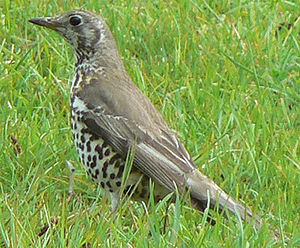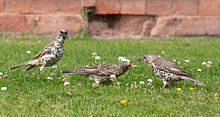- Mistle Thrush
-
For the band, see Mistle Thrush (band).
Mistle Thrush 
Conservation status Scientific classification Kingdom: Animalia Phylum: Chordata Class: Aves Order: Passeriformes Family: Turdidae Genus: Turdus Species: T. viscivorus Binomial name Turdus viscivorus
Linnaeus, 1758Synonyms Mistletoe Thrush
The Mistle Thrush (Turdus viscivorus) is a member of the thrush family Turdidae.
It is found in open woods and cultivated land over all of Europe and much of Asia. Many northern birds move south during the winter, with migrating birds sometimes forming small flocks.
Contents
Taxonomy
This species was first described by Linnaeus in his Systema naturae in 1758 under its current scientific name.[2] The English name refers to its mistletoe eating, as does the scientific name, which is derived from the Latin words Turdus, "thrush", and viscivorus meaning "mistletoe eater".
A recent molecular study places the Mistle Thrush's closest relatives as the similarly plumaged Song Thrush (T. philomelos) and the Chinese Thrush (T. mupinensis), all three species early offshoots from the main Turdus radiation around the world, and hence only distantly related to other European species such as the Common Blackbird (T. merula).[3]
Description
The Mistle Thrush averages about 27 cm long, larger than the similar Song Thrush. The sexes are similar, with plain greyish brown backs and neatly round-spotted underparts. The breast has much less buff than the Song Thrush.
Behaviour
Voice
The male sings its loud melodious song from a tree, rooftop or other elevated perch, often during bad weather or at night, and starting relatively early in the spring — hence the Mistle Thrush's old name of "Stormcock". The song is like a harder and simpler version of the Blackbird's. The alarm call is said to sound like a football rattle (a form of musical ratchet) or machine gun.
Diet
It is omnivorous, eating insects, worms and berries. A Mistle Thrush will defend a berry-bearing tree against other thrushes in winter. Mistletoe berries are amongst its diet.
Breeding
They nest in trees, laying several eggs in a neat cup-shaped nest lined with grass.
References
- ^ BirdLife International (2004). Turdus viscivorus. 2006. IUCN Red List of Threatened Species. IUCN 2006. www.iucnredlist.org. Retrieved on 12 May 2006. Database entry includes justification for why this species is of least concern
- ^ (Latin) Linnaeus, C (1758). Systema naturae per regna tria naturae, secundum classes, ordines, genera, species, cum characteribus, differentiis, synonymis, locis. Tomus I. Editio decima, reformata.. Holmiae. (Laurentii Salvii).. pp. 168. "T. dorso fusco, collo maculis albis, rostro flavescente."
- ^ Voelker G, Rohwer S, Bowie RCK, Outlaw DC (2007). "Molecular systematics of a speciose,cosmopolitan songbird genus: Defining the limits of,and relationships among,the Turdus thrushes". Molecular Phylogenetics and Evolution 42 (2): 422–34. doi:10.1016/j.ympev.2006.07.016. PMID 16971142.
Further reading
- Snow, B.K. & Snow, D.W. (1984). "Long-term defence of fruit by Mistle Thrushes Turdus viscivorus. Ibis 126(1):39-49
External links
Categories:- IUCN Red List least concern species
- Turdidae
- Birds of Nepal
- Birds of Pakistan
- Birds of Palestine
- Birds of Europe
- Birds of Turkey
Wikimedia Foundation. 2010.


